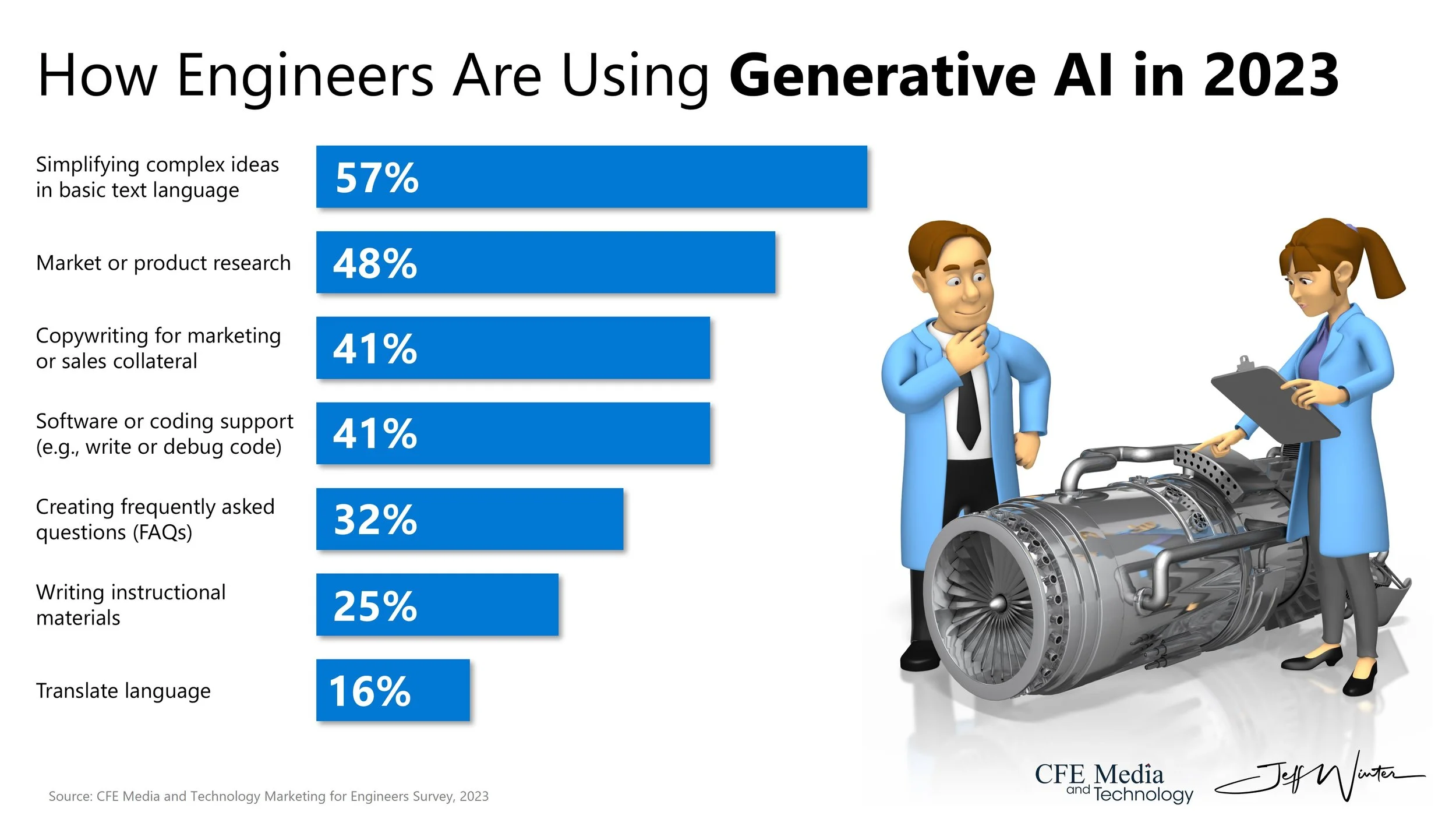How Engineers Are Using Generative AI in 2023
Practicing engineers spend around 20–40% of their time writing, and this number often increases as they move up their career ladder. Most of this writing is related to effectively communicating complex ideas to non-technical stakeholders, simplifying intricate concepts into understandable terms, and conducting detailed market or product research to stay ahead of emerging technologies or solutions.
According to Marketing to Engineers® research from CFE Media and Technology, there are many parts of an engineer's job where generative AI tools like ChatGPT can (and currently are) helping engineers be more effective beyond writing/debugging code.
Litmus Test of Engineers Utilizing Generative AI
A litmus test is a simple and decisive test used to determine the presence or quality of a condition or capability. For engineers considering the implementation of Generative AI, this litmus test provides a framework for evaluating its potential impact and suitability for various tasks.
Research:
Explanation: Generative AI, particularly Language Models (LLMs) and Retrieval-Augmented Generation (RAG), can quickly aggregate and summarize information from multiple sources, saving time on data gathering and providing comprehensive insights.
Question to ask yourself: “Do I need to look up or verify information?”
Example: An engineer tasked with developing a new material for aerospace applications needs to stay updated on the latest research. Using AI, the engineer can quickly compile and summarize recent academic papers, patents, and technical reports on advanced composite materials, thus gaining a thorough understanding of current advancements without spending hours reading each document individually.
Simplification:
Explanation: Generative AI, through Natural Language Processing (NLP), can translate complex technical jargon into simpler terms, making it easier to communicate with non-technical stakeholders and ensuring that everyone involved in a project understands the core concepts.
Question to ask yourself: “Do I need to explain complex concepts to non-experts?”
Example: When presenting a new machine learning model to the marketing team, an engineer can use AI to generate a simplified explanation. Instead of delving into intricate algorithmic details, the AI can produce a summary that highlights how the model improves customer segmentation, using everyday language and analogies that make the concept accessible to those without a technical background.
Idea Generation:
Explanation: Generative AI, using prompt engineering and multimodal AI, can brainstorm creative solutions and suggest alternative approaches to engineering problems, facilitating innovation and diverse perspectives.
Question to ask yourself: “Am I looking for creative solutions or alternative approaches?”
Example: An engineer working on optimizing a manufacturing process can use AI to generate alternative strategies. By inputting various constraints and goals into the AI, they can receive suggestions ranging from new layout designs to alternative materials or methods. This creative input can provide fresh perspectives and potentially reveal solutions that were not initially considered.
Time and Resource Optimization:
Explanation: Generative AI, using AI copilots and project management agents, can help optimize time management and resource allocation, making projects more efficient and cost-effective.
Question to ask yourself: “Can AI help me manage time and resources more effectively?”
Example: In a large-scale construction project, AI can assist project managers by generating detailed schedules and resource plans. By analyzing past project data and current resource availability, the AI can suggest optimal work sequences, identify potential bottlenecks, and propose solutions to minimize downtime. This enables the team to complete the project on time and within budget.
Code Debugging and Writing:
Explanation: AI can assist in writing and debugging code, identifying errors, and suggesting improvements, which can significantly speed up the development process and improve code quality.
Question to ask yourself: “Do I need help with coding or debugging?”
Example: A software engineer developing a complex data analysis tool can use AI to generate initial code for data parsing and visualization. The AI can also assist in debugging by identifying syntax errors and logical inconsistencies, providing suggestions for improvement, and even generating unit tests to ensure the robustness of the code.
Collaboration and Communication:
Explanation: Generative AI, through NLP and agents, can facilitate better communication and collaboration by generating clear and concise documents and summaries, ensuring all team members are aligned and informed.
Question to ask yourself: “Do I need to facilitate better communication within my team or with stakeholders?”
Example: During a multi-departmental project meeting, an engineer can use AI to take detailed notes and generate a summary report. This report can include key decisions, action items, and follow-up tasks, which can be distributed to all participants immediately after the meeting, ensuring everyone is on the same page and understands their responsibilities.
Documentation:
Explanation: AI can generate impressive first drafts of reports, manuals, and other documentation, allowing engineers to focus on refining and finalizing the content, which ensures accuracy and completeness.
Question to ask yourself: “Do I need to create written content quickly?”
Example: An engineer responsible for maintaining an equipment manual can use AI to generate initial documentation based on design specifications and usage guidelines. The AI can format the manual, include necessary safety warnings, and create troubleshooting sections, which the engineer can then review and update with specific details and customizations.
Generative AI as an engineering assistant
No engineer should worry that generative AI will replace them, but every engineer should look for ways it can assist them. Using generative AI as an assistant can make you look brighter, more accurate, and more productive. Who wouldn’t like that?
References
Institute of Electrical and Electronics Engineers - ransactions on Professional Communication (vol. 51, no. 3, pp. 242-263, 2008: https://procomm.ieee.org/the-writing-engineer/
CFE Media - Marketing to Engineers® Study, 2023: https://survey.alchemer.com/s3/7422411/Marketing-to-Engineers-Lunch-and-Learn-Topics

